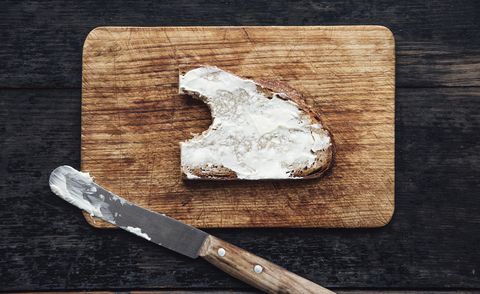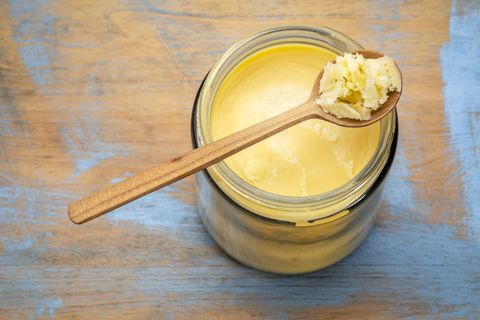Can I Use Crisco Instead Of Butter
What's more land than butter? Whether you're using in different types of cake or stirring into pasta, this rich, flavorful fat really goes with everything.
In the Country Living exam kitchen, we phone call exclusively for unsalted butter in recipes (more than on why below). You can substitute salted for unsalted butter in recipes, just know that yous will need to reduce the amount of added salt in blistering recipes.
Below is a quick breakdown of a few different types of butter and where yous may want to use them.
More From Country Living

Unsalted Butter vs. Salted Butter
The proper noun says it all: Unsalted butter is merely butter that does not take any added salt. With salted butter, during the churning procedure, in one case the salt and buttermilk take separated, common salt is added, and the butter is churned until the table salt dissolves and is evenly distributed.
The corporeality of salt added will vary by make. This is one reason that we telephone call for unsalted butter in the Country Living recipes. For example, Kerry Aureate salted butter has almost half the amount of salt as Country O'Lakes salted offer. If yous added equal amounts of Kerry Aureate versus Land O'Lakes to a blistering recipe, you lot run the hazard of it being as well salty. Calling for unsalted and the verbal corporeality of kosher salt guarantees consistent results.
Additionally, considering of the lack of salt—which acts as a preservative—unsalted butter has a shorter shelf life, so information technology tends to be fresher. Unsalted butter will last about ane calendar month in the refrigerator while salted volition last around ii.
Cultured Butter
Originally made from cream that had been immune to sour, modernistic (a.yard.a. commercially made) cultured butter (sometimes labeled "European-style butter") is created by adding live bacterial cultures to pasteurized cream before churning. The cream is then allowed to residuum and thicken slightly earlier churning.
Cultured butter has a higher fat content (82%-86% vs. fourscore% for uncultured) and a slightly tangy flavor that has hints of hazelnut. The college fat content makes the butter smoother and gives it a richer gustatory modality, making information technology perfect for spreading on a slice of staff of life straight from the oven.
Antiseptic Butter
Clarifying butter is the procedure of removing the h2o and milk solids from butter, leaving you with nearly 100% butterfat. Clarified butter has a much college smoke point than common stick butter, then it'southward great for searing meats or vegetables. Because the milk solids have been removed it too has a much longer shelf life, lasting between three to vi months in the fridge. To make antiseptic butter, starting time past melting a stick, or sticks, of unsalted butter in a saucepan. The butter will start to foam and sputter. Once the sputtering stops, and no more foam is rise to the top, remove it from the estrus and skim off the white milk solids (salve those milk solids to drizzle over popcorn). Next, strain the butter through a fine mesh sieve lined with a coffee filter or several layers of cheese cloth to remove whatsoever straggler solids.
Ghee
This is a similar product to clarified butter, but rather than stopping cooking when the butter is no longer sputtering, it is cooked until milk solids start to dark-brown and fall to the bottom of the pan. The mixture is then strained, as with antiseptic butter, removing the milk solids. Because of the additional cooking time, ghee is shelf stable and tin can last months in the pantry in an closed container. A common ingredient in Indian cooking, try it when you whip upwards your next batch of curry or saag paneer.
This content is imported from OpenWeb. You may be able to discover the same content in another format, or you may be able to find more information, at their spider web site.
Can I Use Crisco Instead Of Butter,
Source: https://www.countryliving.com/food-drinks/a30299534/types-of-butter/
Posted by: helmdoughs.blogspot.com




0 Response to "Can I Use Crisco Instead Of Butter"
Post a Comment